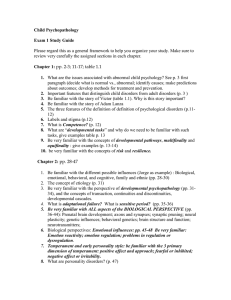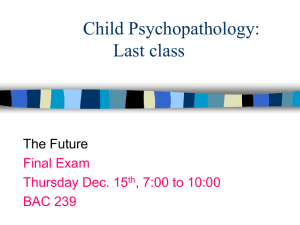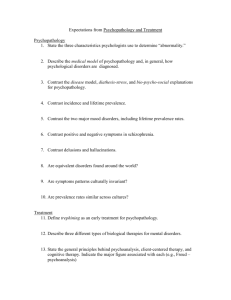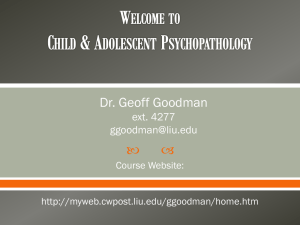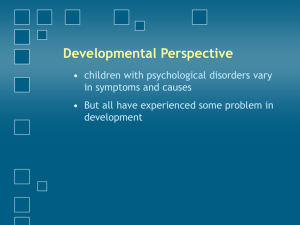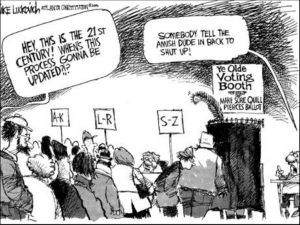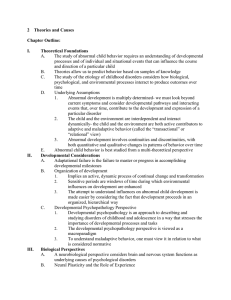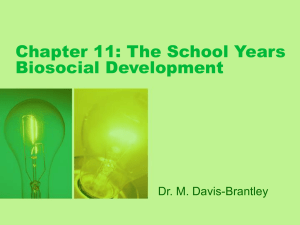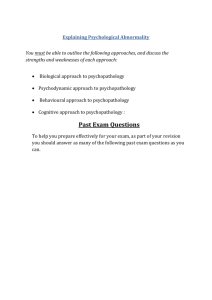Historical Views of Child Psychopathology The Emergence of Social Conscience
advertisement
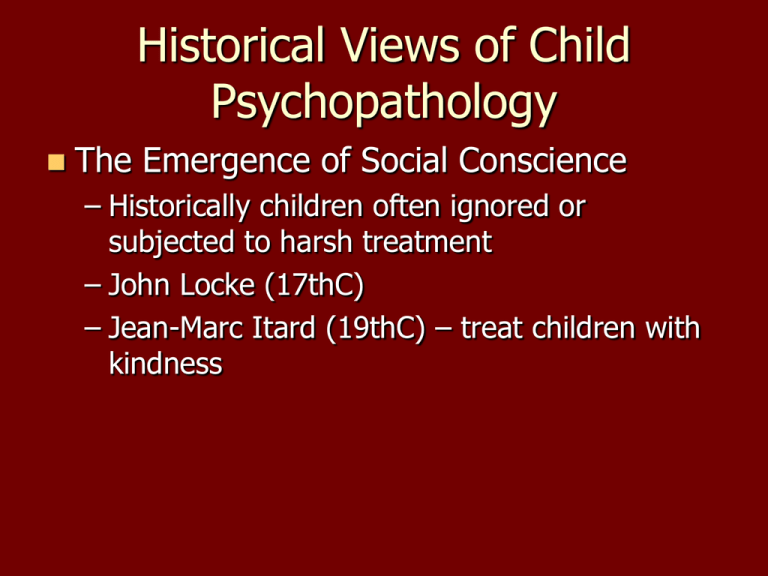
Historical Views of Child Psychopathology The Emergence of Social Conscience – Historically children often ignored or subjected to harsh treatment – John Locke (17thC) – Jean-Marc Itard (19thC) – treat children with kindness Historical Views (cont.) Early Psychological Attributions (for adults, mostly) – emerged in early 1900’s – psychoanalytic theory – behaviorism laid foundation for studying conditioning and elimination of children’s fears Historical Views of Child Psychopathology Child psychopathology generally ignored – Insanity – DSM 1980 version of DSM included a child section Reasons why ignored Psychoanalytic theory Behavior theory Historical Views (cont.) Evolving Forms of Treatment based in historical context – institutionalized – foster families and group homes – behavior therapy Evidence for change in perspective on children’s problems Child-focused journals Divisions of APA Child abuse laws enacted IDEA Change in perspective (cont.) Surgeon General’s report (2001) – 1 in 10 has severe mental or behavior problem – Only 2 of 10 with problems get help Surgeon General’s goals 1. 2. 3. 4. Promote public awareness Develop scientifically proven treatments Improve assessment methods Eliminate ethnic/SES disparities in services Surgeon General’s goals 5. 6. 7. 8. Train frontline providers Monitor access to mental health services Improve infrastructure of services Increase access to mental health services Reasons why child psychopathology is now receiving more attention Problems are common Lifelong consequences Predict adult disorders Few children receive necessary help Develop early intervention programs Legal mandates Defining Psychological Disorders Determining what is normal and abnormal is an arbitrary process Traditionally defined as a pattern of behavioral, cognitive, or physical symptoms, that is associated with one or more of: – distress – disability – increased risk for further suffering or harm Defining Psychological Disorders (cont.) Many childhood problems best depicted in terms of relationships Labels describe behavior, not the child Problems may be the result of children’s attempts to adapt to abnormal or unusual circumstances Need to consider age/developmental level Developmental Pathways Refers to the sequence and timing of behaviors, and the relationship between them over time Two types of developmental pathways: – multifinality: similar early experiences lead to different outcomes – equifinality: different early experiences lead to a similar outcome Developmental Pathways (cont.) Figure 1.1 (a) Multifinality: Similar early experiences lead to different outcomes; (b) Equifinality: Different factors lead to a Developmental Pathways (cont.) With abnormal child psychology, must keep in mind: – there are many contributors to disordered outcomes in each child – contributors vary among children who have the disorder – children express features of their disturbances in different ways – pathways leading to particular disorders are numerous and interactive Issues unique to child psychopathology Referral process Greist et al.: why do parents bring their children in to clinics? – Predicted mother’s ratings of their children – Home observation for objective ratings – Got ratings of mom’s mood/depression Referral process cont. Webster-stratton (1988) – Questions of interest – Method – Results – implications Temperament & reciprocal relationships Innate biological factors which influence behavior – “easy” temperament – “difficult” temperament Easiness to soothe Activity Sociability Parent-child relationships are reciprocal Reciprocal relationships Pelham et al. (1997) – Questions of interest – Method – Results – implications What Affects Rates and Expression of Mental Disorders? Poverty and Socioeconomic Disadvantage – about 1 in 6 children in North America live in poverty – poverty is associated with greater rates of learning impairments and academic problems, conduct problems, chronic illness, hyperactivity, and emotional disorders Rates and Expression (cont.) Sex Differences – sex differences appear negligible in children under age 3, but increase with age – boys > girls in early/middle childhood; girls > during adolescence Figure 1.3 Figure 1.3 Normal developmental trajectories of Externalizing problems (top graph) an Internalizing problems (bottom graph) from the Child Behavior Checklist. Ages are shown on the x axis. The y axis represents the raw scores (higher score means more problems). Source: Bongers, Koot, van der Ende, & Verhulst, Rates and Expression (cont.) Ethnicity – minority children over-represented – once other effects (SES, gender, age, referral status) are controlled for, very few differences emerge in relation to race or ethnicity – minority children face multiple disadvantages Rates and Expression (cont.) Ethnicity – (cont.) Research has often ignored cultural factors Rates and Expression (cont.) Culture – contributes to development and expression of disorders – some underlying processes are similar across diverse cultures
